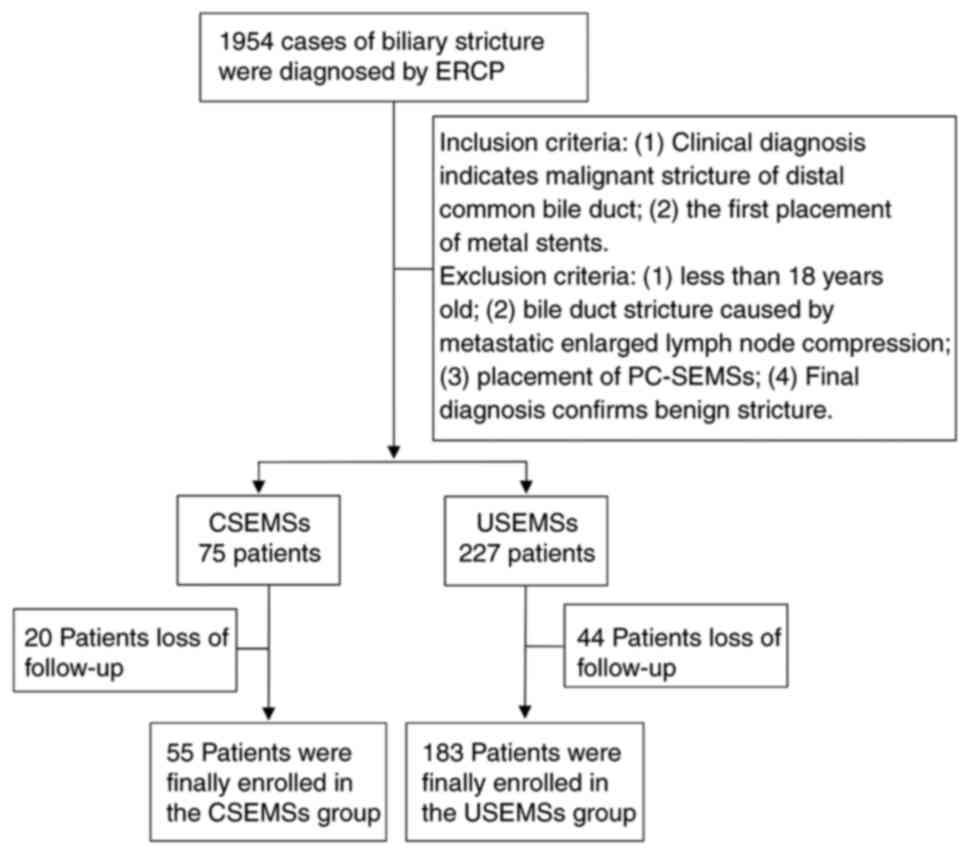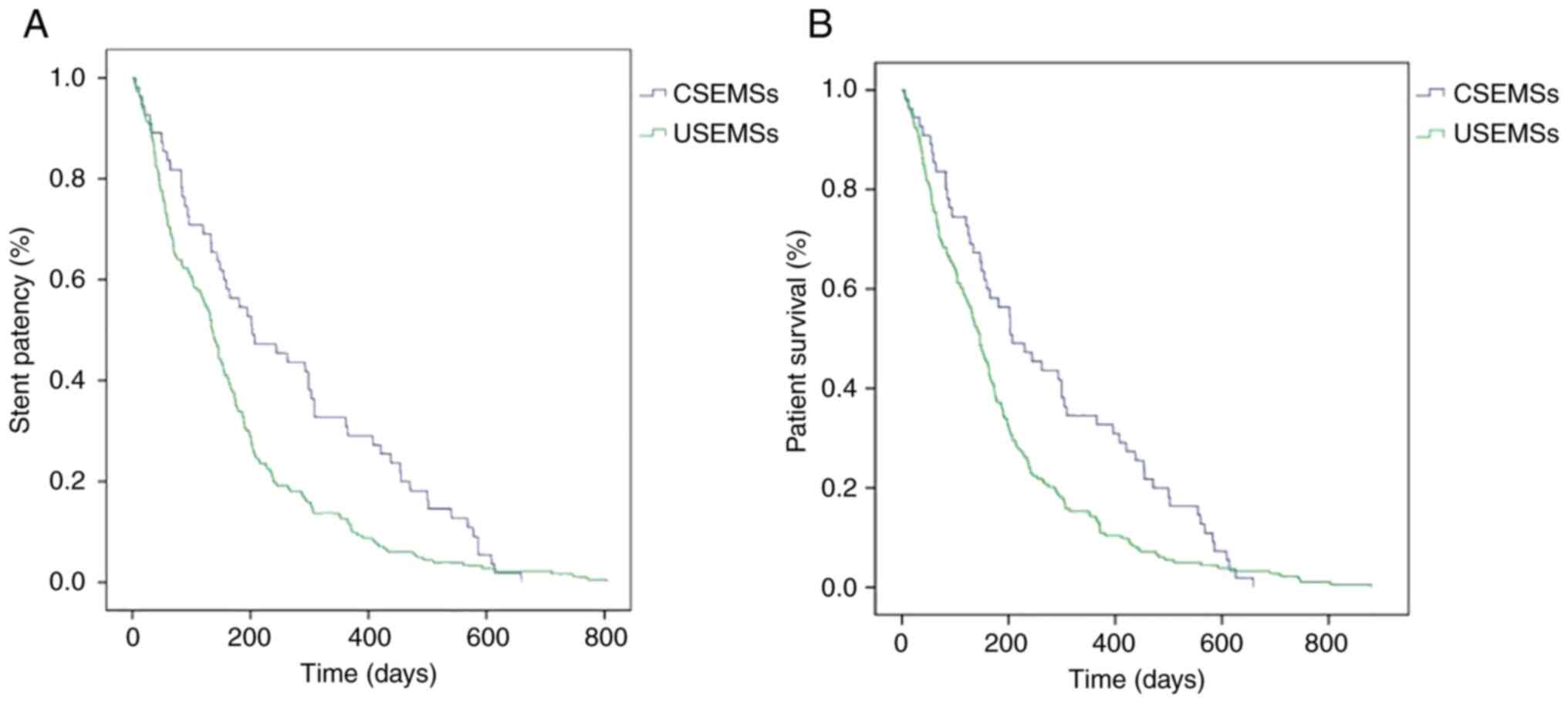|
1
|
Gerges C, Beyna T, Tang RSY, Bahin F, Lau
JYW, van Geenen E, Neuhaus H, Nageshwar Reddy D and Ramchandani M:
Digital single-operator peroral cholangioscopy-guided biopsy
sampling versus ERCP-guided brushing for indeterminate biliary
strictures: A prospective, randomized, multicenter trial (with
video). Gastrointest Endosc. 91:1105–1113. 2020.PubMed/NCBI View Article : Google Scholar
|
|
2
|
Dorrell R, Pawa S and Pawa R: Endoscopic
management of malignant biliary stricture. Diagnostics (Basel).
10(390)2020.PubMed/NCBI View Article : Google Scholar
|
|
3
|
Bray F, Ferlay J, Soerjomataram I, Siegel
RL, Torre LA and Jemal A: Global cancer statistics 2018: GLOBOCAN
estimates of incidence and mortality worldwide for 36 cancers in
185 countries. CA Cancer J Clin. 68:394–424. 2018.PubMed/NCBI View Article : Google Scholar
|
|
4
|
Aadam AA and Liu K: Endoscopic palliation
of biliary obstruction. J Surg Oncol. 120:57–64. 2019.PubMed/NCBI View Article : Google Scholar
|
|
5
|
Wang CC, Yang TW, Sung WW and Tsai MC:
Current endoscopic management of malignant biliary stricture.
Medicina (Kaunas). 56(114)2020.PubMed/NCBI View Article : Google Scholar
|
|
6
|
Sawas T, Al Halabi S, Parsi MA and Vargo
JJ: Self-expandable metal stents versus plastic stents for
malignant biliary obstruction: A meta-analysis. Gastrointest
Endosc. 82:256–267.e7. 2015.PubMed/NCBI View Article : Google Scholar
|
|
7
|
Almadi MA, Barkun A and Martel M: Plastic
vs. self-expandable metal stents for palliation in malignant
biliary obstruction: A series of meta-analyses. Am J Gastroenterol.
112:260–273. 2017.PubMed/NCBI View Article : Google Scholar
|
|
8
|
World Medical Association General
Assembly. World medical association declaration of Helsinki:
Ethical principles for medical research involving human subjects. J
Int Bioethique. 15:124–129. 2004.PubMed/NCBI
|
|
9
|
Nakai Y, Isayama H, Wang HP, Rerknimitr R,
Khor C, Yasuda I, Kogure H, Moon JH, Lau J, Lakhtakia S, et al:
International consensus statements for endoscopic management of
distal biliary stricture. J Gastroenterol Hepatol. 35:967–979.
2020.PubMed/NCBI View Article : Google Scholar
|
|
10
|
Fernandez Y, Viesca M and Arvanitakis M:
Early diagnosis and management of malignant distal biliary
obstruction: A review on current recommendations and guidelines.
Clin Exp Gastroenterol. 12:415–432. 2019.PubMed/NCBI View Article : Google Scholar
|
|
11
|
Singhi AD, Nikiforova MN, Chennat J,
Papachristou GI, Khalid A, Rabinovitz M, Das R, Sarkaria S, Ayasso
MS, Wald AI, et al: Integrating next-generation sequencing to
endoscopic retrograde cholangiopancreatography (ERCP)-obtained
biliary specimens improves the detection and management of patients
with malignant bile duct strictures. Gut. 69:52–61. 2020.PubMed/NCBI View Article : Google Scholar
|
|
12
|
Yoon WJ, Lee JK, Lee KH, Lee WJ, Ryu JK,
Kim YT and Yoon YB: A comparison of covered and uncovered
Wallstents for the management of distal malignant biliary
obstruction. Gastrointest Endosc. 63:996–1000. 2006.PubMed/NCBI View Article : Google Scholar
|
|
13
|
Kim JY, Ko GB, Lee TH, Park SH, Lee YN,
Cho YS, Jung Y, Chung IK, Choi HJ, Cha SW, et al: Partially covered
metal stents may not prolong stent patency compared to uncovered
stents in unresectable malignant distal biliary obstruction. Gut
Liver. 11:440–446. 2017.PubMed/NCBI View
Article : Google Scholar
|
|
14
|
Smith AC, Dowsett JF, Russell RC, Hatfield
AR and Cotton PB: Randomised trial of endoscopic stenting versus
surgical bypass in malignant low bileduct obstruction. Lancet.
344:1655–1660. 1994.PubMed/NCBI View Article : Google Scholar
|
|
15
|
Kaassis M, Boyer J, Dumas R, Ponchon T,
Coumaros D, Delcenserie R, Canard JM, Fritsch J, Rey JF and Burtin
P: Plastic or metal stents for malignant stricture of the common
bile duct? Results of a randomized prospective study. Gastrointest
Endosc. 57:178–182. 2003.PubMed/NCBI View Article : Google Scholar
|
|
16
|
Song TJ, Lee JH, Lee SS, Jang JW, Kim JW,
Ok TJ, Oh DW, Park DH, Seo DW, Lee SK, et al: Metal versus plastic
stents for drainage of malignant biliary obstruction before primary
surgical resection. Gastrointest Endosc. 84:814–821.
2016.PubMed/NCBI View Article : Google Scholar
|
|
17
|
Yokota Y, Fukasawa M, Takano S, Kadokura
M, Shindo H, Takahashi E, Hirose S, Kawakami S, Fukasawa Y, Sato T
and Enomoto N: Partially covered metal stents have longer patency
than uncovered and fully covered metal stents in the management of
distal malignant biliary obstruction: A retrospective study. BMC
Gastroenterol. 17(105)2017.PubMed/NCBI View Article : Google Scholar
|
|
18
|
Kitano M, Yamashita Y, Tanaka K, Konishi
H, Yazumi S, Nakai Y, Nishiyama O, Uehara H, Mitoro A, Sanuki T, et
al: Covered self-expandable metal stents with an anti-migration
system improve patency duration without increased complications
compared with uncovered stents for distal biliary obstruction
caused by pancreatic carcinoma: a randomized multicenter trial. Am
J Gastroenterol. 108:1713–1722. 2013.PubMed/NCBI View Article : Google Scholar
|
|
19
|
Saleem A, Leggett CL, Murad MH and Baron
TH: Meta-analysis of randomized trials comparing the patency of
covered and uncovered self-expandable metal stents for palliation
of distal malignant bile duct obstruction. Gastrointest Endosc.
74:321–327. 2011.PubMed/NCBI View Article : Google Scholar
|
|
20
|
Isayama H, Komatsu Y, Tsujino T, Sasahira
N, Hirano K, Toda N, Nakai Y, Yamamoto N, Tada M, Yoshida H, et al:
A prospective randomised study of ‘covered’ versus ‘uncovered’
diamond stents for the management of distal malignant biliary
obstruction. Gut. 53:729–734. 2004.PubMed/NCBI View Article : Google Scholar
|
|
21
|
Kullman E, Frozanpor F, Söderlund C,
Linder S, Sandström P, Lindhoff-Larsson A, Toth E, Lindell G, Jonas
E, Freedman J, et al: Covered versus uncovered self-expandable
nitinol stents in the palliative treatment of malignant distal
biliary obstruction: Results from a randomized, multicenter study.
Gastrointest Endosc. 72:915–923. 2010.PubMed/NCBI View Article : Google Scholar
|
|
22
|
Lee JH, Krishna SG, Singh A, Ladha HS,
Slack RS, Ramireddy S, Raju GS, Davila M and Ross WA: Comparison of
the utility of covered metal stents versus uncovered metal stents
in the management of malignant biliary strictures in 749 patients.
Gastrointest Endosc. 78:312–324. 2013.PubMed/NCBI View Article : Google Scholar
|
|
23
|
Li J, Li T, Sun P, Yu Q, Wang K, Chang W,
Song Z and Zheng Q: Covered versus uncovered self-expandable metal
stents for managing malignant distal biliary obstruction: A
meta-analysis. PLoS One. 11(e0149066)2016.PubMed/NCBI View Article : Google Scholar
|
|
24
|
Chen MY, Lin JW, Zhu HP, Zhang B, Jiang
GY, Yan PJ and Cai XJ: Covered stents versus uncovered Stents for
unresectable malignant biliary strictures: A meta-analysis. Biomed
Res Int. 2016(6408067)2016.PubMed/NCBI View Article : Google Scholar
|
|
25
|
Park DH, Kim MH, Choi JS, Lee SS, Seo DW,
Kim JH, Han J, Kim JC, Choi EK and Lee SK: Covered versus uncovered
wallstent for malignant extrahepatic biliary obstruction: A cohort
comparative analysis. Clin Gastroenterol Hepatol. 4:790–796.
2006.PubMed/NCBI View Article : Google Scholar
|
|
26
|
Conio M, Mangiavillano B, Caruso A,
Filiberti RA, Baron TH, De Luca L, Signorelli S, Crespi M, Marini
M, Ravelli P, et al: Covered versus uncovered self-expandable metal
stent for palliation of primary malignant extrahepatic biliary
strictures: A randomized multicenter study. Gastrointest Endosc.
88:283–291. 2018.PubMed/NCBI View Article : Google Scholar
|
|
27
|
Seo DW, Sherman S, Dua KS, Slivka A, Roy
A, Costamagna G, Deviere J, Peetermans J, Rousseau M, Nakai Y, et
al: Covered and uncovered biliary metal stents provide similar
relief of biliary obstruction during neoadjuvant therapy in
pancreatic cancer: A randomized trial. Gastrointest Endosc.
90:602–612. 2019.PubMed/NCBI View Article : Google Scholar
|
|
28
|
Flores Carmona DY, Alonso Lárraga JO,
Hernández Guerrero A and Ramírez Solís ME: Comparison of covered
and uncovered self-expandable stents in the treatment of malignant
biliary obstruction. Rev Esp Enferm Dig. 108:246–249.
2016.PubMed/NCBI View Article : Google Scholar
|
|
29
|
Tringali A, Hassan C, Rota M, Rossi M,
Mutignani M and Aabakken L: Covered vs. uncovered self-expandable
metal stents for malignant distal biliary strictures: A systematic
review and meta-analysis. Endoscopy. 50:631–641. 2018.PubMed/NCBI View Article : Google Scholar
|
|
30
|
Almadi MA, Barkun AN and Martel M: No
benefit of covered vs uncovered self-expandable metal stents in
patients with malignant distal biliary obstruction: A
meta-analysis. Clin Gastroenterol Hepatol. 11:27–37.e1.
2013.PubMed/NCBI View Article : Google Scholar
|
|
31
|
Yang MJ, Kim JH, Yoo BM, Hwang JC, Yoo JH,
Lee KS, Kang JK, Kim SS, Lim SG, Shin SJ, et al: Partially covered
versus uncovered self-expandable nitinol stents with anti-migration
properties for the palliation of malignant distal biliary
obstruction: A randomized controlled trial. Scand J Gastroenterol.
50:1490–1499. 2015.PubMed/NCBI View Article : Google Scholar
|
|
32
|
Siddiqui AA, Mehendiratta V, Loren D, Hong
SK and Kowalski T: Fully covered self-expandable metal stents are
effective and safe to treat distal malignant biliary strictures,
irrespective of surgical resectability status. J Clin
Gastroenterol. 45:824–827. 2011.PubMed/NCBI View Article : Google Scholar
|
|
33
|
Moole H, Bechtold ML, Cashman M, Volmar
FH, Dhillon S, Forcione D, Taneja D and Puli SR: Covered versus
uncovered self-expandable metal stents for malignant biliary
strictures: A meta-analysis and systematic review. Indian J
Gastroenterol. 35:323–330. 2016.PubMed/NCBI View Article : Google Scholar
|
|
34
|
Mangiavillano B, Montale A, Frazzoni L,
Bianchetti M, Sethi A, Repici A and Fuccio L: Endoscopic biliary
self-expandable metallic stent in malignant biliary obstruction
with or without sphincterotomy: Systematic review and
meta-analysis. Endosc Int Open. 7:E26–E35. 2019.PubMed/NCBI View Article : Google Scholar
|
|
35
|
Yamashita Y, Tachikawa A, Shimokawa T,
Yamazaki H, Itonaga M, Sakai Y, Sugiyama H, Nakai Y, Tanaka K,
Isayama H and Kitano M: Covered versus uncovered metal stent for
endoscopic drainage of a malignant distal biliary obstruction:
Meta-analysis. Dig Endosc. 34:938–951. 2022.PubMed/NCBI View Article : Google Scholar
|
|
36
|
Isayama H, Komatsu Y, Tsujino T, Yoshida
H, Tada M, Shiratori Y, Kawabe T and Omata M: Polyurethane-covered
metal stent for management of distal malignant biliary obstruction.
Gastrointest Endosc. 55:366–370. 2002.PubMed/NCBI View Article : Google Scholar
|
|
37
|
Lee BS, Ryu JK, Jang DK, Chung KH, Yoon
WJ, Kim J, Woo SM, Lee SH, Lee WJ and Kim YT: Reintervention for
occluded metal stent in malignant bile duct obstruction: A
prospective randomized trial comparing covered and uncovered metal
stent. J Gastroenterol Hepatol. 31:1901–1907. 2016.PubMed/NCBI View Article : Google Scholar
|
|
38
|
Telford JJ, Carr-Locke DL, Baron TH,
Poneros JM, Bounds BC, Kelsey PB, Schapiro RH, Huang CS,
Lichtenstein DR, Jacobson BC, et al: A randomized trial comparing
uncovered and partially covered self-expandable metal stents in the
palliation of distal malignant biliary obstruction. Gastrointest
Endosc. 72:907–914. 2010.PubMed/NCBI View Article : Google Scholar
|
















